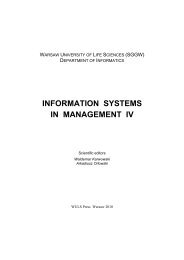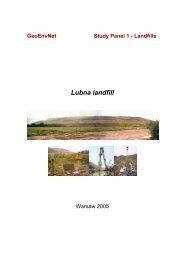ACTA SCIENTIARUM POLONORUM - SGGW
ACTA SCIENTIARUM POLONORUM - SGGW
ACTA SCIENTIARUM POLONORUM - SGGW
Create successful ePaper yourself
Turn your PDF publications into a flip-book with our unique Google optimized e-Paper software.
120 J. WiśniewskaEvery society can be described as comprising of four dimensions, the economic, social,environmental and institutional. Each of them is a complex, dynamic, self-organising andevolving entity in its own right, making the coupled system one of tremendous complexity.For this system to be sustainable, each of the four subsystems has to maintain its capabilityto survive and evolve, while the interlinks of the subsystem must enable a permanentco-evolution [Spangenberg 2005]. This is the context in which the concept of sustainabledevelopment has taken root – i.e. that of linking the economic, social and environmentalobjectives of societies in a balanced way [OECD 2001]. The immense significance of institutionalencirclement of agriculture does not allowed to neglect the institutional subsystemin the multi-dimensional evaluation of sustainability in agriculture [Wiśniewska 2009].ASSESSMENT OF SUSTAINABLE DEVELOPMENTThe concept of sustainable development has already been defined in at least a fewdozen times. Some researchers associate it with an identical rate of growth in all the sectorsand regions of an economy, others link it with a strive at improving the quality of allpeople’s lives. It is called the conception of eco-development by some other scientists.‘Sustainable development’ means that the achieved progress results in the developmentof a contemporary generation, but at the same time, it creates a potential which is necessaryto meet the needs of future generations [Pearce, Barbier, Markandya 2000]. It is,no doubt, a complicated, long-term process, considered in an infinite time horizon. Theprobability of sustainable growth appearing in economy is little. Sustainable developmentbecame the aspiration of the majority of world’s economies in the 1990s. It is a key objectiveof the European Union which aims to continually improve the quality of life andwell-being for present and future generations [European’s... 2009].Continuous and indefinitely (or at least long-term) sustained growth is – often implicitly– assumed to be a part of the concept of sustainable development of the economy bymost authors. Under the standard assumptions of economic growth, the rate of growth isconsidered the only relevant parameter [Spangenberg 2005]. On the other hand, economicsustainability refers to the standard of living in the society and the distribution of incomeas well as the level of poverty while economic growth might be the subject of definingincome inequalities within the society [Kuznets 1955]. Income and social inequalitiesare increasing simultaneously to the upper trend of economic growth, but the trend occursonly initially and then fell – the inverted – U that has become known as the KuznetsCurve [Stiglitz 2001]. A comprehensive studies and statistic reports show growing unequalincome distribution and poverty in the OECD countries. According to the latestOECD report the gap between rich and poor has grown in more than three-quarters of theOECD countries over the past two decades [OECD 2008a].Sustainability means putting into effect all the aspirations within the limitations of thepresent resources. A particular choice of one of a number of aims often requires maintainingthe rest of the aimed values at minimum levels. All the aims may naturally opposeeach other or even compete with each other. However, they can also be comparativeor complementary, creating a closed unit. While considering the conception of sustainableeconomic development, a holistic approach is necessary with regard to each of itsaspects. Synergetic “win-win-win-win” options can only be identified if all four dimen-Acta Sci. Pol.
















